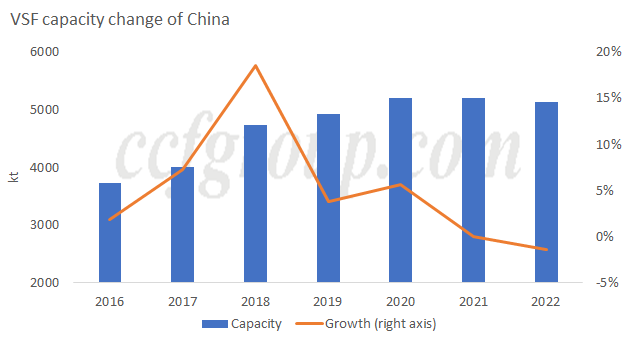Brief analysis on China VSF supply and demand in 2022
In 2022, when the global economic situation was not good and the epidemic situation in China was repeated, the operation was not ideal. Given sluggish demand, VSF plants were forced to reduce the operating rates and achieve a relative balance between supply and demand through the contraction of supply.

VSF capacity of China decreased in 2022 when no new units were put into operation, and some capacities were removed from the list by idling for several years. According to CCFGroup's statistics, VSF capacity of Chinese mainland was 5.13 million tons/yr.
The growth rate of VSF capacity expansion has slowed down after the capacities were launched on a large scale in 2018. The market once showed signs of recovery after the absorption in 2019, but under the impact of the epidemic, the growth of VSF faced challenges again. Some old lines were faced with elimination.
In 2022, there was minor increase of VSF downstream capacity and vortex-spun yarn was still the main source of growth. Although the overall capacity of spun yarn was increasing, due to the impact of the epidemic and insufficient demand, the operating rate of yarn industry in 2022 was significantly lower than that in 2021, with a drop of more than 10%. At the same time, the increase in the proportion of blended yarn had also led to a decline in the production of rayon yarn.
The capacity expansion of nonwovens industry slowed down in 2022. The capacity expansion in Xinjiang was faster, but that in other areas was slower. The number of total machines reached just above 500 sets, and about 550kt of VSF was consumed by nonwovens in China throughout the year. On the whole, VSF consumption of China in 2022 might be reduced by around 7.6% year on year.
2023 is a year of unprecedented complexity, with both the benefits of post-epidemic recovery and the challenge of global recession. On the whole, domestic demand is expected to recover in 2023, and the growth rate will be higher than that in 2022. The overseas demand is not optimistic, and it remains to be seen whether it can maintain the level of 2022. There will be no new capacity of VSF in 2023, but operating rate has remained below 80% since the epidemic, and there is room for supply growth.
- Top keywords
- Cotton Price
- Cotton Futures Price
- Cotton Futures
- CZCE
- PTA Futures Price
- Chemical Fiber
- Polyester Prices
- Wool price
- PTA Futures
- Shengze Silk
- China
- Yarn Price
- price
- China Textile City
- Fibre Price
- Benzene Price
- Cotton
- Index
- Cotton Index
- PTA
- fabric price
- NYMEX
- Top 10
- textile industry
- Spot Cotton
- Cotton Yarn
- Polyester Price
- Futures
- PTA Price
- cotton yarn price

